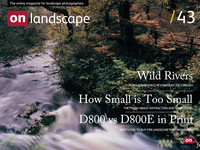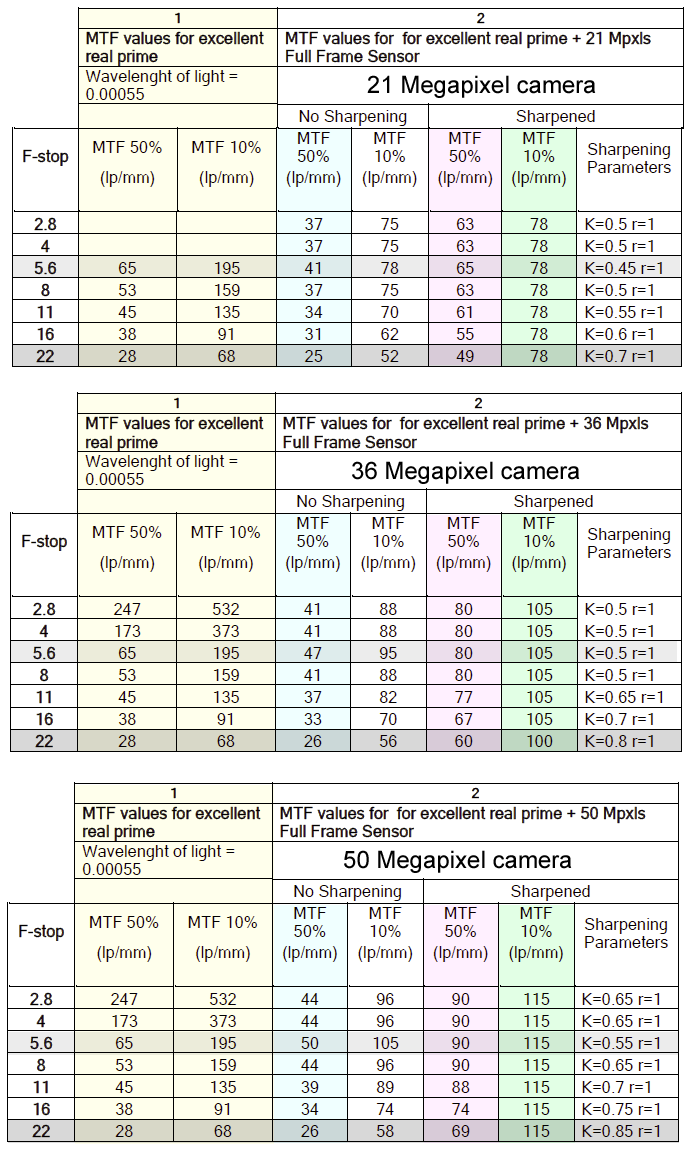How small is too small?

Tim Parkin
Amateur Photographer who plays with big cameras and film when in between digital photographs.
I think most photographers will have come across various online resources, books, magazines and blog posts telling them that certain apertures are 'out of bounds' and that in order to get the sharpest pictures they need to use a narrow band of apertures (usually f/5.6 or f/8 for 35mm cameras). As mentioned in last issue though, a test of some lenses seen recently where smaller aperture results on the D800 resolved more than the best aperture results on a 5Dmk3 got us thinking. Last week myself, Mark Banks and Joe Cornish met up to run some tests where we used the 36Mp Nikon D800E and a 24Mp Sony A900 (same sensor as the Nikon D3X) at various apertures to find out just how much affect diffraction had on our final prints.
NB: Please note that due to a bug related to a wordpress plugin (Portfolio Slideshow Pro) the slideshow is not working properly in Chrome but does in Firefox - we haven't checked other browsers but are talking to the developers
Now testing this is fairly simple, we take a couple of cameras and shoot a test target at a range of apertures. The trick is, how do we sharpen them. Well - only trial and error can fix this one and so after using our test target in Joe's studio, I spent an afternoon trying different sharpening strategies.
I finally settled on the application of two rounds of sharpening, one at a very fine radius and one at a broader radius and then a final unsharp mask to bring contrast back up. Before we show the effects of this though, let's have a look at the range of apertures for the D800E.
[sravnitel id=1 images="10206,10207,10208,10209,10210,10211,10212" width=682 height=627 center_x=341 center_y=314 zoom=1 showtitles=true showtoggle=true]
Now you can obviously see the effects of diffraction here and the f/22 looks incredibly soft. However, let's apply our custom sharpening to each of these and see what we can come up with.
[sravnitel id=2 images="10218,10219,10220,10221,10222,10223,10224" width=702 height=646 center_x=352 center_y=323 zoom=1 showtitles=true showtoggle=true]
Now things are looking a little closer but the f/22 shot still looks like it has lost of a bit of contrast. However, the final test is to print these and stick them in front of some unsuspecting punters. So we did. And they couldn't tell the difference....
Now it's worth restating that - real live punters couldn't tell the difference between a shot taken at f/5.6 and one taken at f/22.
We tried this at various print resolutions and for everything from 360dpi to 240dpi our punters couldn't tell the difference. At 180dpi it does look like the f/22 has lost a bit of 'bite' and contrast but the f/16 looks fine. If the photos weren't shown side by side I don't think people could have told the difference.
We repeated the test for the A900 and got slightly different results - first of all here are the unsharpened 100% apertures.
[sravnitel id=3 images="10226,10227,10228,10229,10230,10231" width=628 height=421 center_x=314 center_y=210 zoom=1 showtitles=true showtoggle=true]
Now when we sharpen these files we get a little surprise in that the f/22 result does show more significant reduction in quality. The smaller apertures are also showing more noise when sharpened. This just shows how clean the D800 images were that they could take such strong sharpening without showing much textural noise. However, when printed the f/22 result does well but starts to show some quality loss at about 240dpi.
[sravnitel id=4 images="10236,10237,10238,10239,10240,10241" width=628 height=421 center_x=314 center_y=210 zoom=1 showtitles=true showtoggle=true]
Our final comparison was to confirm what we had seen that got us thinking about things - what would the f/22 D800 file look like in comparison with a Sony A900 f/8 file? Well, the answer is that they're pretty close with the D800 getting a cleaner result. Surprising yes?
[sravnitel id=5 images="10245,10246" width=670 height=417 center_x=335 center_y=209 zoom=1 showtitles=true showtoggle=true]
Finally one of our readers (Simone - tjshot) sent us a link to his research where he used variously well sourced theoretical figures to calculate the potential of various sensors given optimal sharpening. You can look at his research yourself although be warned it is quite in depth. He's given us permission to reproduce a couple of the most pertinent tables here though.
The following tables give a lot of information but I've highlighted the critical parts. The three tables show a 21, 36 and 50 megapixel camera. Each row shows a different aperture. The yellow columns show the theoretical resolution of the lens for 50% contrast (MTF 50) and for 10% contrast (MTF 10).
Now the figures that are normally quoted for cameras are the unsharpened MTF 50 (50% contrast) values which you can see in pale blue. From this you can see that the value of 26 lp/mm for f/22 is a fraction of the 47 lp/mm for f/5.6 (on the 36Mp camera).
However, if we add sharpening(pink column) we get 60 lp/mm for f/22 compared with 80 lp/mm for 5.6. And finally, if we look at the 10% contrast figures with sharpening (green column), we see that 100 lp/mm for f/22 and 105 for f/5.6!! Hardly any difference. And this is for simple sharpening!
As Simone has shown, the resolving power of a 36mp camera at f/22 does out resolve a 21Mp sensor at any aperture setting. And into the future, a 50Mp sensor will continue to out resolve the 36Mp sensor, even at f/22. This has even been shown in practise as the 7D has the same pixel density as a possible full frame 50Mp camera.
We've done a couple of Ad-Hoc tests on 'pictorial' subject matter and the 'theory' holds up well (I've reduced this to 60% to give you an idea of what it looks like in print - you'll have to trust me that it looks very close). Our own conclusion is that you should be absolutely fine shooting at f/16 and if you need f/22, go for it!
[sravnitel id=6 images="10251,10252" width=682 height=518 center_x=341 center_y=259 zoom=1 showtitles=true showtoggle=true]
Summary
We showed that for the D800E, the f/22 result could be sharpened until it was a fairly close match for the f/8 or f/5.6 image, albeit with some additional texture and lower overal contrast. When printed, it was difficult to make out the difference unless they were made at 180dpi or less. f/16 could be sharpened until it was identical in print.
The diffraction at f/22 also served the purpose of removing any moire effects completely (and at f/16 it was very small). When compared the the Sony A900 results we also confirmed that the Nikon D800E at f/22 is sharper than the Sony A900 at f/5.6 - a remarkable result!
It was also interesting that the Sony A900 shot at f/22 wasn't quite as sharp as it's f/5.6 f/8 result - the reduction in contrast and increase in noise/texture was enough to reduce the f/22 result somewhat. f/16 did look good though. It seems that you need more resolution and cleaner files to make the most of these f/22 results.
Furthermore we had the theoretical contribution from Simone which which correlated well with our findings in that the contrast at f/22 is reduced by about 20% but the detail is still all there. Simone has also worked out the results for a 50Mp sensor and has confirmed that we should see the same effects with theoretical 50Mp camera outresolving the Nikon D800E even when shot at f/22.
Conclusion
You can't beat resolution. Modern sharpening techniques have allowed the treatment of f/22 images so that they are almost indistinguishable from f/5.6 & f/8 images. And further resolution will continue to show resolution and contrast improvements even up to 50Mp (and possibly beyond).
It may even be that a 50Mp image shot at f/32 could outresolve a Canon 5dmk3 at f/5.6! The megapixel race is far from over.
p.s. When we did the tests of this on the Canon 5DSr, we found that f/22 was on 50mp was actually marginally sharper than f/11 at 24mp


